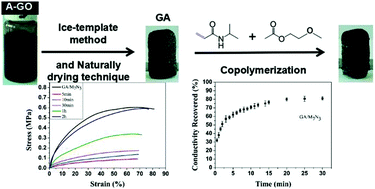Rapid room-temperature self-healing conductive nanocomposites based on naturally dried graphene aerogels†
Abstract
Recent progress on flexible electronics has inspired remarkable efforts in the design and fabrication of novel conductive soft materials. However, the combination of room-temperature self-healing and highly conductive properties in flexible composite materials remains a great challenge. Herein, we describe the construction of conductive nanocomposites through an in situ copolymerization of N-isopropylacrylamide and 2-methoxyethyl acrylate in naturally dried graphene-based aerogels, which show ultralow density below 10 mg cm−3, superelasticity, and high conductivity up to 120 S m−1. The resulting nanocomposites with less than 1 wt% graphene loading achieve superior conductivity of 70 S m−1 and rapid room-temperature self-healing properties. On rupture, the mechanical properties recover to more than 98% of the virgin sample within 2 h and the electrical properties recover to above 80% of their original conductivity within 15 minutes. The high room-temperature healing efficiency is attributed to the reversible hydrogen bonding and sufficient chain entanglement enabled by the low glass transition temperature of the copolymer. It is further demonstrated that the graphene-based conductive nanocomposites can be used as strain sensors for human motion detection. We believe that the flexible conductive nanocomposites could find numerous applications in wearable electronic devices, sensors, and soft robotics.



 Please wait while we load your content...
Please wait while we load your content...